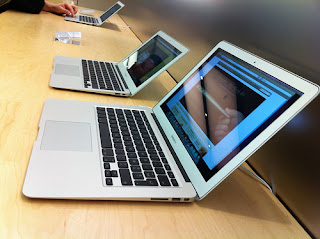I wavered on the purchase of the new Macbook Air for almost 24 hours, and, for those of you that know me, you will realize this is odd. I had done all the research ahead of time, drove to an Apple store to see one (but they had not received one yet), and talked to some very smart colleagues who talked me out of it.
 |
| Photo by http://www.flickr.com/photos/rsepulveda/5104919191/ |
I then polled my Twitter followers, but no one had yet touched one, let alone purchased one. However, I looked carefully at both the specs and the hype, and decided to get the 11.6" version, doubled the RAM to 4GB, doubled the SSD to 128GB and upgraded the processor to the 1.6 GHz. I did not want to get caught with an underpowered machine again, but the total price was a little daunting!
I cannot believe this little machine! It is powerful enough to do Second Life (my avatar is iffy, but everything else renders perfectly!), it can video edit using Adobe Premiere Elements 9 for the Mac, and opens all apps so speedily, it takes your breath away!
I restored a Time Machine backup of my Macbook Pro and the new MBA was all ready to go! With the smaller amount of internal storage, I did uninstall most of the Adobe CS apps, but kept the ones I am most likely to use away from home like Dreamweaver and Acrobat Pro.
After the install of all my applications, I have about 60GB of data storage left, and that is fine for my purposes. With so much of my data available "in the cloud" and on my home computer via "Back to My Mac", I am all set by having everything available to me all of the time!
I miss a couple of things so far. Not the optical drive, but the back-lit keyboard and SD card slot. The larger model has the SD card slot, and I know that the battery life is longer without the back-lit keyboard, but I still wish it had it.
I have to remember to carry both the VGA dongle and the Ethernet dongle with me now, but that is not a problem. I have hooked the computer up to a older projector and the "non-standard" resolution works just fine.
Please feel free to ask any questions in the comments of things you want me to try out or concerns of yours I might have missed!





